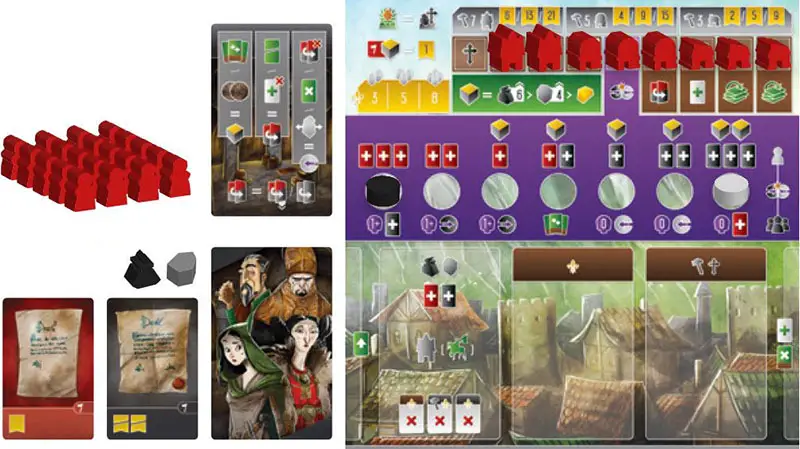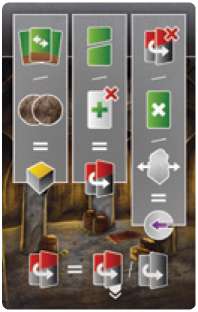
Setup
Setup for you remains mostly the same. To set up the AI player, follow these steps:
-
Choose 1 of the Player Boards and flip it over to the AI Player Board side. The top-left of AI Player Boards give you an idea on what they will focus on strategically (placing Workers, constructing Buildings, etc). We will use the Cleric AI for this example.
-
As with the regular Player Board, place the 9 Buildings onto the AI Player Board (notice that the positions of Trading Posts and Guildhalls are reversed . Give the AI opponent their 20 Workers, Virtue and Corruption Markers, Viscount and AI Reference Card. They do not require the Townsfolk Cards.
-
Give yourself the Start Player Marker.
-
Separate the Starting Schemes (Brown Headers) from the Future Schemes (Black Headers). Check the left card space of the AI Player Board to see which Scheme Cards need to be removed.
Return those to the box. Shuffle the Starting Schemes and place them in a facedown pile to the left of the AI Player Board.
Shuffle the Future Schemes and place them somewhere off to the side of the AI Player's Board, so not to confuse the Future Scheme Draw Pile with the main Scheme Draw Pile.
-
During Step 8 of the standard Setup rules, reveal 1 less pair of Player Cards and Hero Townsfolk Cards (2 pairs for a standard solo game.
You choose first, then place the AI's Viscount on the indicated space on the Main Board, of the unselected Player Card. You can then return that Player Card and Hero Townsfolk Card to the box.

General Rules
For the most part, the solo game plays very much like the standard game. Your turns function exactly the same. On your opponent's turn, you will be turning over a single Scheme Card from their Draw Pile and resolving a number of effects. This will simulate the feeling of facing off against a real opponent.
There are a few general rules to follow when making decisions for the AI opponent. Most of these are printed as a reminder on the AI Reference Card:

The AI Viscount only ever moves clockwise around the outside path of the Main Board. They do not use the inside path.

Both the AI and yourself will give their opponent a Rearrange ability when landing on the same space as their Viscount. As the AI Reference Card indicates, this gives the AI a resource of their choice.

When gaining a resource of their choice, most AI opponents will follow the chart on their Player Board (area with the green background). Only the Card-focused AI treats all resources as a single type.
For example, the Cleric AI prioritizes collecting Ink Wells. If they already have 6 or more, they will instead collect Stone. If they already have 4 or more Stone, they will collect Gold.

The AI Reference Card indicates what the AI will do when resolving certain effects:
Column 1: Any time they gain a Rearrange effect or 2 Silver, they instead gain 1 resource of their choice.
Column 2: Any time they gain a Destroy effect, or their Future Scheme Draw Pile is empty when they need to gain a card, they gain a Card Flip.
Column 3: Any time they gain a Card Flip, but have no cards to flip, they gain 1 Virtue. They also gain 1 Virtue when told to Discard or gain a free Castle Move.

When given the choice of which card to flip (Debt or Deed, the AI will first attempt to flip that which they have flipped the least of.
If they are tied, they will flip a Debt. If they only have 1 type available to flip, they will simply flip 1 of those.

All these icons serve the same purpose for the AI: They simply add 1 card from the top of the Future Scheme Draw Pile, faceup on top of their discard pile.

This icon indicates that the AI will dismiss the Townsfolk Card currently adjacent to their Viscount. The card is removed from the game and they gain the immediate effect on the top right of the card.
Unlike when human players dismiss Townsfolk, the Al does not gain the Icons from these cards to help fund their actions.

This icon is the AI's "Primary Focus". When told to take this action, refer to the top left of the AI's Player Board as to what that action is.

When the AI's Draw Pile runs out, they will likely have already dropped off 1 card from their Player Board, leaving only 2 cards on their Player Board when shuffling. This is intended.
Actions

When constructing Buildings, the AI always wants to place their left-most Building (that they can afford) from their Player Board, onto the left-most (in clockwise direction) available Building Spot of the Main Board (where their Viscount currently stands).
The AI gains effects from Building Spots and Links, just like human players. The AI cannot cross the River to place Buildings either.
When resolving an effect to immediately construct a Building for free (such as from a Manuscript), they will first attempt to construct it on the left-most (in clockwise direction) available Building Spot of the Main Board, where their Viscount currently stands.
If that Building Spot is taken, they will continue moving clockwise around the Main Board (even crossing Rivers) until they find an available Building Spot. Only if all Building Spots are taken, will they forfeit this effect.

When taking a Noble action to place Workers in the Castle, the AI can do this from the outside path. They simply place their Workers into the first tier of the Main Board Segment where their Viscount currently stands.
The AI always wants to place as many Workers as possible. Note on the AI Player Board, that the AI will never attempt to place a single Worker for their action. When given the chance to bump Workers, the AI will always target you.
The AI can gain the Castle Leader Card for the bonus 5 VP at the game's end, but they gain no benefit from the increased hand limit. If the AI has multiple groups of 3 or more Workers on the first tier to resolve, they always resolve in clockwise order from the section adjacent to their Viscount.
If given a choice of rewards on the second tier of the Castle, they AI always takes the first option.
When resolving an effect to place Workers for free (such as from a Manuscript), they always place those Workers into the first tier of the Main Board Segment where their Viscount currently stands.

When transcribing Manuscripts, the AI can do this from the outside path. They focus on the Manuscript from the Main Board Segment where their Viscount currently stands. If the AI gains a Cleric Bonus Card, it collects it just like a human player would.
When resolving an effect to transcribe a Manuscript for free (such as from a Manuscript), they will first attempt to transcribe the Manuscript from the Main Board Segment where their Viscount currently stands.
If that Manuscript cannot be taken, due to the restrictions of the effect, they will continue moving clockwise around the Main Board until they find a Manuscript they can collect. Only if none of the Manuscripts can be taken, will they forfeit this effect.
Game Turns
At the start of the AI's turn, shift all cards on their Player Board 1 space to the right (just like the standard game. Next, turn over the top card from their Scheme Card Draw Pile, placing it into the left space of their Player Board.
After doing so, simply carry out all the effects listed on the card from top-to-bottom. Note that the Icons at the top of each card do not indicate an effect. They are simply there to help the AI fund their actions.
End of the Game
The game ends the same way as the standard game, keeping in mind that the AI will always take the final turn.

The AI scores Victory Points in the exact same way as human players. However, it also gains 1 VP per leftover resource. Players are reminded of this on the AI's Player Board.
To win against the AI, you need to score more Victory Points than them. If you want a challenge, see if you can beat all 4 different AI opponents.
If you wish to increase the difficulty if any AI opponent, try shuffling 1, 2 or 3 Future Scheme Cards into their Scheme Draw Pile during Setup.

Continue Reading